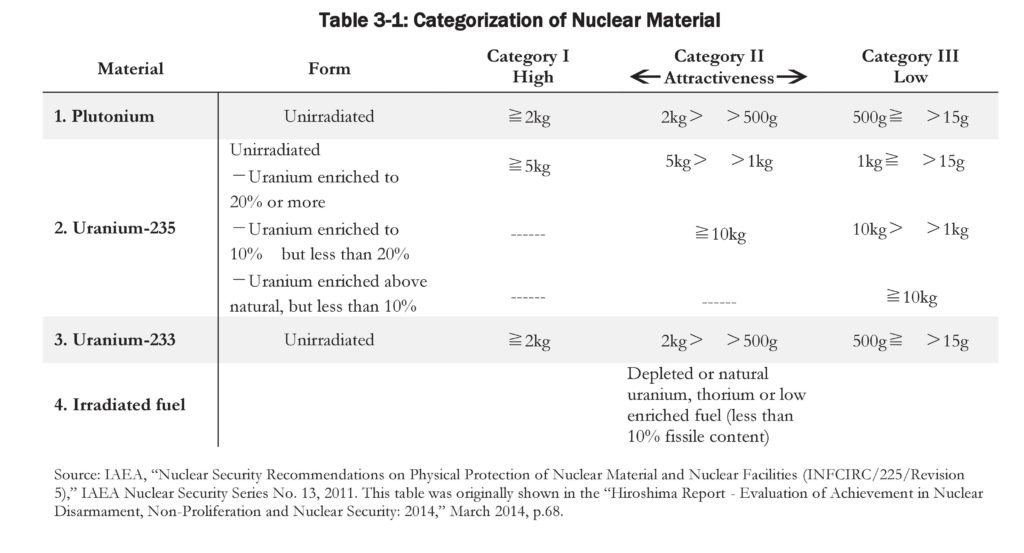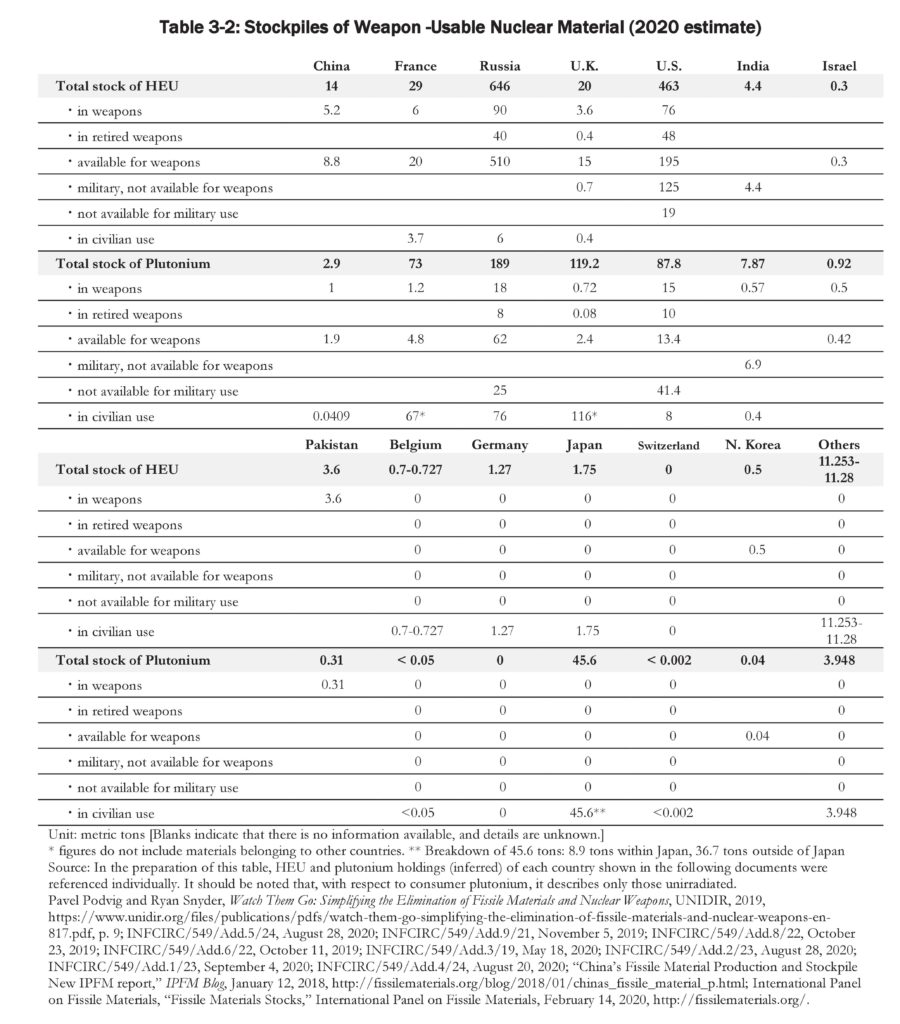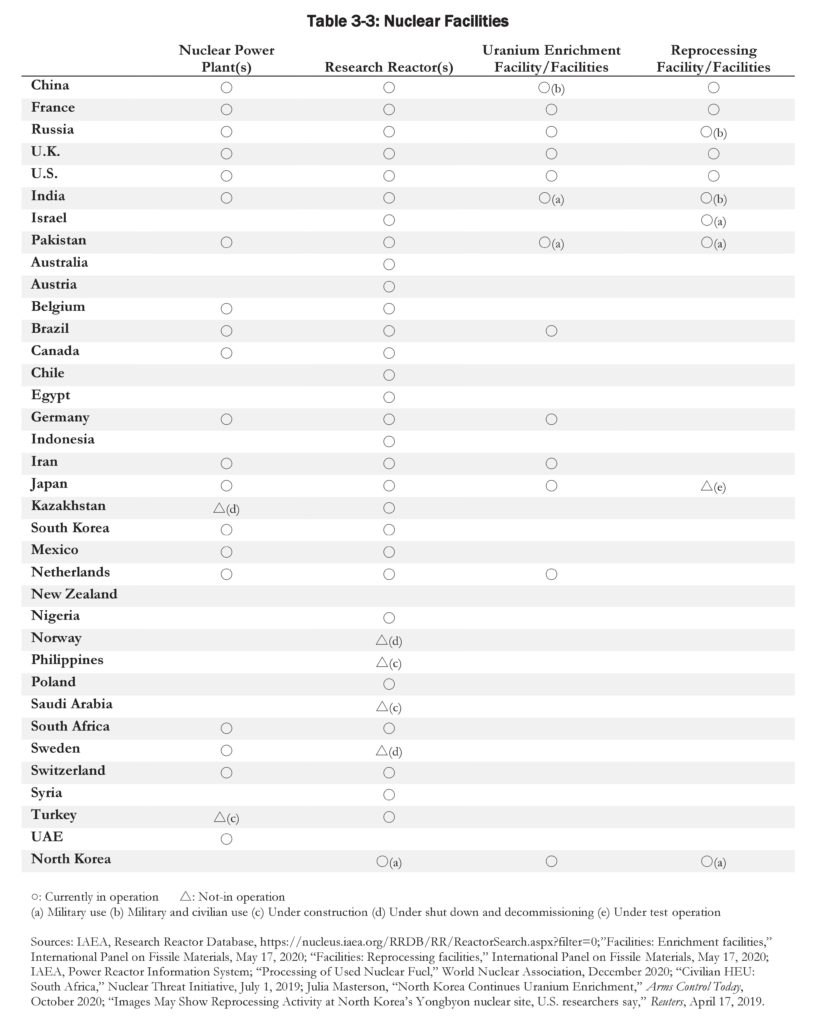Chapter 3 Nuclear Security1 (1) Physical Protection of Nuclear Materials and Facilities
A) Nuclear Materials
The IAEA defines a term “nuclear security” as “the prevention of, detection of, and response to, criminal or intentional unauthorized acts involving or directed at nuclear material, other radioactive material, associated facilities, or associated activities.”2
On the subject of physical protection, a major element of nuclear security measures, the latest version of the IAEA’s “Nuclear Security Recommendations on Physical Protection of Nuclear Material and Nuclear Facilities,” also known as INFCIRC/225/Rev.5, was published in 2011. In this revised edition, the IAEA recommends that requirements for physical protection “should be based on a graded approach, taking into account the current evaluation of the threat, the relative attractiveness, the nature of the nuclear material and potential consequences associated with the unauthorized removal of nuclear material and with the sabotage against nuclear material or nuclear facilities.”3
As shown in Table 3-1 shows, the type of nuclear material itself is the primary factor for determining the physical protection measures against unauthorized removal. The different types of nuclear material are categorized in terms of element, isotope, quantity, and irradiation. This categorization then forms the basis for a graded approach to protection against unauthorized removal of “attractive” nuclear material that could be used in a nuclear explosive device, which itself depends on the types of nuclear material, isotopic composition, physical and chemical form, degree of dilution, radiation level, and quantity.4
Weapons-grade fissile materials are generally thought to be attractive to terrorists who are looking to produce nuclear explosive devices. Therefore, these materials require high-level protection measures. In this regard, the amount of weapon-usable nuclear materials and the number of facilities that contain such materials in a country are considered to be one of the important indicators for the assessment that state’s effort in enhancing nuclear security. Table 3-2, which is based on various open-source information, shows the amount of weapons-usable fissile materials held by the countries surveyed for this report. The following surveyed countries, not included in Table 3-2, are also assumed to possess highly enriched uranium (HEU) as of November 2020.

➢ More than 1 metric ton (category I is 5 kg and more): Kazakhstan (approximately10,000kg, irradiated)5
➢ 1 kg or more: Canada (less than 838kg)6, Australia (2.726 kg unirradiated, 0.02 kg irradiated)*7, Iran (6 kg, irradiated), the Netherlands (approximately 600 kg), Norway (less than 1 kg unirradiated, 3kg irradiated)*8, and South Africa (approximately 700 kg unirradiated)9
➢ Less than 1 kg: Syria * Figures updated as of 2020
As a result of efforts made by the Global Threat Reduction Initiative (GTRI), the number of countries that have completely removed HEU has increased in recent years. The surveyed countries that have achieved complete removal of HEU are: Austria, Brazil, Chile, Indonesia, South Korea, Mexico, Nigeria, the Philippines, Poland, Sweden, Switzerland and Turkey.10

B) Radioactive Material
Security of radioactive material, and radioactive sources in particular, is another important issue. At the IAEA International Conference on Nuclear Security 2020 (ICONS 2020), which took place February 2020 in Vienna, IAEA Member States at the minister level expressed their commitment to “maintaining effective security of radioactive sources throughout their life cycle, consistent with the objective of ‘the Code of Conduct on the Safety and Security of Radioactive Sources’ and its supplementary guidance documents” in the Ministerial Declaration adopted at the Conference.11
This Code of Conduct was published by the IAEA in January 2004, and 140 countries have made a political commitment to implement the Code, as of August 2020.12 All the surveyed countries, except North Korea, have already made such a commitment. The Code of Conduct is not a legally binding instrument, but rather involves convening a meeting every three years “to report on progress, exchange lessons learned, and discuss areas in need of improvement.” It provides a platform for the countries that have made a commitment to conduct a wide-ranging exchange of information concerning the national implementation of the Code.13 At the last meeting, which took place in 2019, the IAEA noted the following three areas where improvement is remained necessary: an independent regulatory body, control of radioactive sources, and radioactive sources out of regulatory control.14
In 2020, the following relevant efforts were made to strengthen radioactive sources made at the international and regional levels: a side event “Strengthening the Security of High Activity Sealed Radioactive Sources” was jointly organized by Germany, France, and the United States during the ICONS 202015, and the “Regional Training Course on Establishing a National Register of Radiation Sources for Latin America” was organized by the IAEA in March 2020.16
As for national efforts, the following remarks were made by several surveyed countries as part of their national statements during ICONS 2020:
➢ The United States17: made a political commitment to meet the intent of “the Supplemental Guidance to the Code of Conduct on the Management of Disused Radioactive Sources.” Since 2016, the United States has “replaced 138 high-activity sources with non-radioisotopic alternatives,” and “published information on best practices for such replacements.”
➢ Australia18: continues “to support work that facilitates effective management of radioactive sources, including assisting member states with disposal solutions and technologies for disused radioactive materials.”
➢ The United Kingdom19: is “looking to replace Caesium irradiators in” its health and research sectors with alternatives which do not contain radioactive sources. By working to dispose of, and reduce demand for, these materials, the United Kingdom aims to join a growing international movement towards alternative technologies.
➢ France20: continued to adapt its legislative and regulatory framework to the evolving threat since ICONS in 2016, and “in particular, strengthened regulatory framework applicable to the security of radioactive sources.”
➢ Japan21: “has enacted a domestic law which obligates operators dealing with nuclear and other radioactive materials to take necessary nuclear security measures. Under the new law, operators are required to take protection measures for radioactive sources.”
➢ Canada22: “is providing $9.65 million towards strengthening the security of radioactive sources in 19 countries in Africa, Latin America and the Pacific.”
C) Nuclear Facilities
Nuclear facilities that could be a target of sabotage which may incur potential serious radiological consequences include
1) nuclear power plants, 2) research reactors, 3) uranium enrichment facilities, and 4) reprocessing facilities. As of November 2020, there were 442 (±0) reactors operating worldwide, 52 (-1) under construction, 100 (-10) being planned, and 326 (-4) proposed to be built. (Numbers in parentheses above and below indicate the increase or decrease compared with the previous
year).23
With respect to research reactors,24 as of November 2020, there were a total of 846 (-11) worldwide. Below is the breakdown of the status of the 846 research reactors:
➢ Operational: 222 (-1)
➢ Temporary Shutdown: 14 (±0)
➢ Under Construction: 11 (+2)
➢ Planned: 17 (+3)
➢ Extended Shutdown: 13 (±0)
➢ Permanent Shutdown: 58 (±0)
➢ Decommissioned: 446 (+3)
➢ Under Decommissioning: 65(-1)
On the security of research reactors, the Co-Presidents’ Report of ICONS 2020 notes that when discussing approaches for risk assessment at research reactors, “explicit consideration of cyber and insider risks could be useful.”25
Regarding HEU spent fuel assemblies at research reactors, there are 20,663 enriched to levels above 20%, with 9,532 of those 20,663 enriched to levels at or above 90%.26 The figures for those fuel assemblies remain the same as last year. The second largest number of fuel assemblies are those with concentrations of 40% or less, which number 7,485. In terms of geographical distribution, 10,627 HEU spent fuel assemblies are currently stored in Eastern Europe, 4,273 in Western Europe, 3,492 in Asia, 1,614 in North America 572 are in Africa and Middle East, and 85 in Latin America.27 This status of affairs shows that strengthening preventive measures for sabotage against research reactor facilities remains of vital importance.
Uranium enrichment and reprocessing facilities are regarded as particularly “attractive” from the viewpoint of malicious actors, such as terrorists who may seek to make nuclear explosive devices. Table 3-3 shows the presence of uranium enrichment and reprocessing facilities as well as nuclear power plants and research reactors in the countries surveyed.
In relation to sabotage against nuclear related facilities, in July 2020, a fire broke out at the Natanz central centrifuge assembly workshop in Iran. A month later, a spokesman for Iran’s Atomic Energy Organization announced that the fire was the result of sabotage.28 Because the workshop did not contain any radioactive material, the fire did not cause any radiological consequences. Nevertheless, this incident served to remind us of the importance of nuclear security measures protecting against sabotage.
Also, in relation to sabotage, recent discussions among nuclear security experts include the threat of drones. In September 2019, an oil facility of Saudi Arabia’s state-owned company Aramco was attacked by military drones.29 The incident indicated that terrorists could also utilize a similar tactic to severely damage critical infrastructure. On the threat of drones, the U.S. Nuclear Regulatory Commission (NRC) said in an unclassified document published in October 2019 that nuclear power plants “do not have any risk-significant vulnerabilities that could be exploited” by attacks using commercially available drones that would result in “radiological sabotage” or theft of “special nuclear material (essentially the reactor fuel).” In the meantime, the NRC also said it would continue evaluating the impact of drone technologies.30

1 Chapter 3 was authored by Junko Horibe. In writing this chapter, the corresponding chapter of the Hiroshima Report 2020 written by Sukeyuki Ichimasa was referenced.
2 IAEA, “Nuclear Security Series Glossary Version 1.3 (November 2015) Updated,” p. 18.
3 IAEA, “Nuclear Security Series No.13 Nuclear Security Recommendations on Physical Protection of Nuclear Material and Nuclear Facilities (INFCIRC/225/Rev.5),” 2011, paragraph 3.37.
4 INFCIRC/225/Rev.5, paragraph 4.5.
5 “Materials: Highly Enriched Uranium,” International Panel on Fissile Material, May 22, 2020, http://fissilematerials.org/materials/heu.html; National Nuclear Security Administration, “Kazakhstan and U.S. Cooperate to Eliminate Highly Enriched Uranium in Kazakhstan,” September 22, 2020, https://www.energy.gov/nnsa/articles/kazakhstan-and-us-cooperate-eliminate-highly-enriched-uraniumkazakhstan;“Civilian HEU: Who Has What?” Nuclear Threat Initiative, October 2019, https://media.nti.org/documents/heu_who_has_what.pdf; “Statement of Canada,” ICONS 2020, February 2020.
6 “Civilian HEU: Who Has What?” Nuclear Threat Initiative, October 2019, https://media.nti.org/documents/heu_who_has_what.pdf; “Statement of Canada,” ICONS 2020, February 2020; “Canada, USA Complete Used Fuel Return,” World Nuclear News, February 13, 2020, https://world- nuclear-news.org/Articles/Canada,-USA-complete-used-fuel-return.
7 INFCIRC/912/Add.4, March 5, 2020.
8 INFCIRC/912/Add.3, August 19, 2019, p. 3.
9 “Civilian HEU: South Africa,” Nuclear Threat Initiative, July 1, 2019, https://www.nti.org/analysis/articles/civilian-heu-south-africa/.
10 “Materials: Highly Enriched Uranium,” International Panel on Fissile Material, May 22, 2020, http://fissilematerials.org/materials/heu.html.
11 “Ministerial Declaration,” ICONS 2020, February 2020, p. 2.
12 IAEA, “List of States Expressing a Political Commitment,” August 27, 2020, https://nucleus.iaea.org/sites/ns/code-of-conduct-radioactive-sources/Documents/Status_list%2027%20August%202020.pdf.
13 “Wider Implementation of IAEA Code of Conduct to Enhance Safety and Security: Review Meeting Concludes,” IAEA, June 11, 2019, https://www.iaea.org/newscenter/news/wider-implementation-ofiaea-code-of-conduct-to-enhance-safety-and-security-review-meeting-concludes.
14 Ibid.
15 “Statement of Germany,” ICONS 2020, February 2020, p. 5.
16 IAEA, Nuclear Security Report 2020, GOV/2020/31-GC (64)/6, August 12, 2020, p. 15.
17 “Statement of United States of America,” ICONS 2020, February 2020, p.4.
18 “Statement of Australia,” ICONS 2020, February 2020, p. 4.
19 “Statement of United Kingdom,” ICONS 2020, February 2020, p. 15.
20 “Statement of France,” ICONS 2020, February 2020.
21 “Statement of Japan,” ICONS 2020, February 2020.
22 “Statement of Canada,” ICONS 2020, February 2020, p. 2.
23 “World Nuclear Power Reactors & Uranium Requirements,” World Nuclear Association, November 2020, https://www.world- nuclear.org/information-library/facts-and-figures/world-nuclear-power-reactors-and-uranium-requireme.aspx.
24 IAEA, “Research Reactor Data Base,”https://nucleus.iaea.org/RRDB/RR/ReactorSearch.aspx?rf=1.
25 “Co-Presidents’ Report,” ICONS 2020, February 2020, p. 11.
26 IAEA, “Worldwide HEU and LEU Assemblies by Enrichment,” https://nucleus.iaea.org/RRDB/Reports/Container.aspx?Id=C2.
27 IAEA, “Regionwise distribution of HEU and LEU,” https://nucleus.iaea.org/RRDB/Reports/Container.aspx?Id=C1.
28 “Iran Nuclear: Fire at Natanz Plant ‘Caused by Sabotage,’’’ BBC, August 23, 2020, https://www.bbc.com/news/world-middle-east-53884701; Parisa Hafezi, “Iran Official Says Sabotage Caused Fire at Natanz Nuclear Site-TV,” Reuters, August 23, 2020, https://www.reuters.com/article/us-iran-nuclearnatanz-idUSKBN25J0M1.
29 “Saudi Arabia Oil Facilities Ablaze after Drone Strikes,” BBC News, September 14, 2019.
30 Kelsey Davenport, “NRC Will Not Require Drone Defenses,” Arms Control Today, December 2019,https://www.armscontrol.org/act/2019-12/news-briefs/nrc-not-require-drone-defenses; “Drones and Nuclear Power Plant Security,” United States Nuclear Regulatory Commission, November 4, 2020,https://www.nrc.gov/reading-rm/doc-collections/fact-sheets/fs-drone-pwr-plant-security.html.






